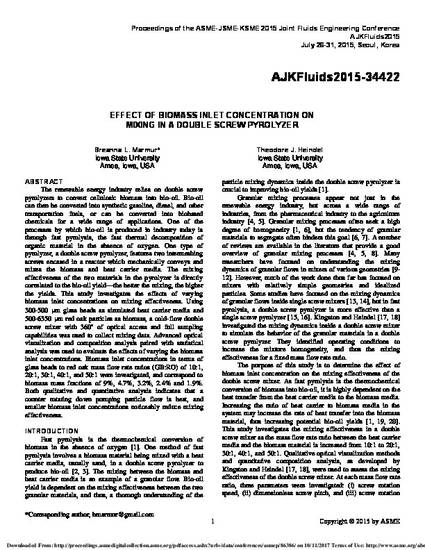
The renewable energy industry relies on double screw pyrolyzers to convert cellulosic biomass into bio-oil. Bio-oil can then be converted into synthetic gasoline, diesel, and other transportation fuels, or can be converted into biobased chemicals for a wide range of applications. One of the processes by which bio-oil is produced in industry today is through fast pyrolysis, the fast thermal decomposition of organic material in the absence of oxygen. One type of pyrolyzer, a double screw pyrolyzer, features two intermeshing screws encased in a reactor which mechanically conveys and mixes the biomass and heat carrier media. The mixing effectiveness of the two materials in the pyrolyzer is directly correlated to the bio-oil yield — the better the mixing, the higher the yields. This study investigates the effects of varying biomass inlet concentrations on mixing effectiveness. Using 300–500 μm glass beads as simulated heat carrier media and 500–6350 μm red oak particles as biomass, a cold-flow double screw mixer with 360° of optical access and full sampling capabilities was used to collect mixing data. Advanced optical visualization and composition analysis paired with statistical analysis was used to evaluate the effects of varying the biomass inlet concentrations. Biomass inlet concentrations in terms of glass beads to red oak mass flow rate ratios (GB:RO) of 10:1, 20:1, 30:1, 40:1, and 50:1 were investigated, and correspond to biomass mass fractions of 9%, 4.7%, 3.2%, 2.4% and 1.9%. Both qualitative and quantitative analysis indicates that a counter rotating down pumping particle flow is best, and smaller biomass inlet concentrations noticeably reduce mixing effectiveness.
Available at: http://works.bepress.com/breanna-marmur/1/

This proceeding is published as Marmur, B.L.., and Heindel, T.J., “Effect of Biomass Inlet Concentration on Mixing in a Double Screw Pyrolyzer,” Proceedings of ASME-JSME-KSME Joint Fluids Engineering Conference 2015 (AJK2015-FED), July 26-31, 2015, Seoul, South Korea, Paper AJK2015-34422, 2015. DOI: 10.1115/AJKFluids2015-34422. Posted with permission.